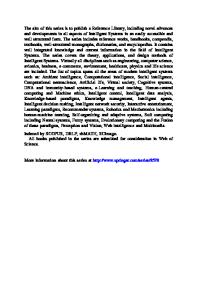Flexible Radio: A Framework for Optimized Multimodal Operation via Dynamic Signal Design
- PDF / 838,413 Bytes
- 14 Pages / 600 x 792 pts Page_size
- 26 Downloads / 264 Views
Flexible Radio: A Framework for Optimized Multimodal Operation via Dynamic Signal Design Ioannis Dagres Institute of Accelerating Systems & Applications (IASA), National Kapodistrian University of Athens (NKUA), P.O. Box 17214, 10024 Athens, Greece Email: [email protected]
Andreas Zalonis Institute of Accelerating Systems & Applications (IASA), National Kapodistrian University of Athens (NKUA), P.O. Box 17214, 10024 Athens, Greece Email: [email protected]
Nikos Dimitriou Institute of Accelerating Systems & Applications (IASA), National Kapodistrian University of Athens (NKUA), P.O. Box 17214, 10024 Athens, Greece Email: [email protected]
Konstantinos Nikitopoulos Institute of Accelerating Systems & Applications (IASA), National Kapodistrian University of Athens (NKUA), P.O. Box 17214, 10024 Athens, Greece Email: [email protected]
Andreas Polydoros Institute of Accelerating Systems & Applications (IASA), National Kapodistrian University of Athens (NKUA), P.O. Box 17214, 10024 Athens, Greece Email: [email protected] Received 16 March 2005; Revised 19 April 2005 The increasing need for multimodal terminals that adjust their configuration on the fly in order to meet the required quality of service (QoS), under various channel/system scenarios, creates the need for flexible architectures that are capable of performing such actions. The paper focuses on the concept of flexible/reconfigurable radio systems and especially on the elements of flexibility residing in the PHYsical layer (PHY). It introduces the various ways in which a reconfigurable transceiver can be used to provide multistandard capabilities, channel adaptivity, and user/service personalization. It describes specific tools developed within two IST projects aiming at such flexible transceiver architectures. Finally, a specific example of a mode-selection algorithmic architecture is presented which incorporates all the proposed tools and, therefore, illustrates a baseband flexibility mechanism. Keywords and phrases: flexible radio, reconfigurable transceivers, adaptivity, MIMO, OFDM.
1.
INTRODUCTION
The emergence of speech-based mobile communications in the mid 80s and their exponential growth during the 90s have paved the way for the rapid development of new wireless standards, capable of delivering much more advanced services to the customer. These services are and This is an open access article distributed under the Creative Commons Attribution License, which permits unrestricted use, distribution, and reproduction in any medium, provided the original work is properly cited.
will be based on much higher bit rates than those provided by GSM, GPRS, and UMTS. The new services (video streaming, video broadcasting, high-speed Internet, etc.) will demand much higher bit rates/bandwidths and will have strict QoS requirements, such as the received BER and the end-to-end delay. The new and emerging standards (WiFi, WiMax, DVB-T, S-DMB, IEEE 802.20) will have to compete with the ones based on wired communications and overcome the barriers posed by the
Data Loading...











